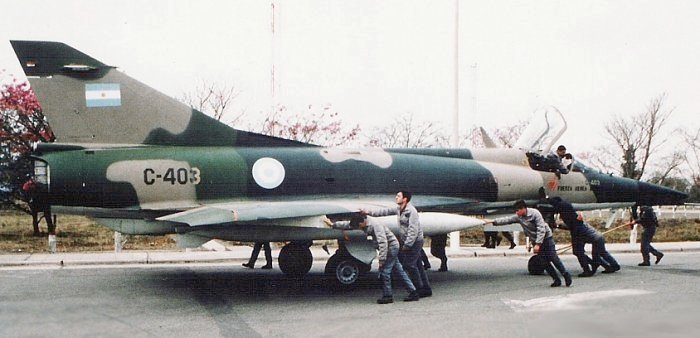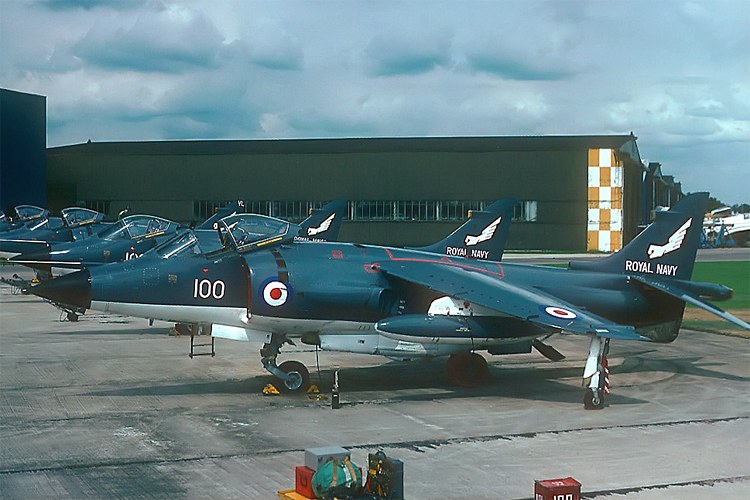The Sea Harrier’s Extra Dark Sea Grey color scheme, which made it very difficult to see over land or sea, earned it the nickname “La Muerta Negra” (The Black Death) among Argentine pilots
The account of a stressful combat air patrol flight by two Sea Harrier planes of the Royal Navy during Operation Sutton.
When they destroyed 23 Argentine aircraft for no casualties in that area of action during the 1982 Falklands War, Royal Navy Sea Harriers demonstrated their value in air-to-air combat.
Operation Sutton (the British landings on the Falklands) started on May 21, 1982, and the Fuerza Aérea Argentina (FAA, Argentine Air Force) launched multiple attack missions against the Royal Navy fleet. On board HMS Invincible (R05), the Sea Harriers from 801 Naval Air Squadron engaged Argentinean aircraft in the afternoon, first shooting down a Pucara and then fending off three Daggers that were attempting to attack the British fleet.

Two Daggers attacked HMS Brilliant, which was anchored close to the San Carlos village, later in the day. The cannon shells damaged the operations room, resulted in injuries, and hurt a Fighter Direction Officer (FDO). Falklands The Air War by R. Burden, M. Draper, D. Rough, C. Smith, and D. Wilton claims that the same FDO observed three further Daggers on his radar screen and directed two Sea Harriers that were conducting a Combat Air Patrol (CAP) in the area toward them.
Lt. Steve Thomas and Lt. Cdr. Nigel Ward flew the two British planes. Thomas recognized the Daggers as belonging to Grupo 6 De Caza (6th Air Brigade) as they had passed over the enemy aircraft due to their yellow fin identification bands and wings. The enemy fighters’ pilots were Flt. Lt. Jorge Senn, Maj. Gustavo Justo Piuma, and Capt. Guillermo Donadille.

The moment the Argentines spotted the Sea Harriers, they jettisoned their underwing stores and started to climb in an attempt to intercept them. However, Thomas dove in behind Piuma’s Dagger and fired an AIM-9L, disabling the fighter as it attempted to elude the Sidewinder by making a quick turn to the right. Piuma miraculously managed to safely exit his airplane.
Thomas next launched a second missile, this time aiming it at Donadille’s aircraft, which blew up when the Sidewinder impacted the port wing of his Dagger. Donadille had also successfully ejected before his aircraft crashed, and the fighter did not disintegrate but instead went into an uncontrollable spin. When the Dagger was attempting to escape the furball, Ward fired an AIM-9L at the ship, destroying the final Dagger Senn had flown. Senn safely exited his fighter before it entirely disintegrated around him.
Following the fight, Brilliant vectored Ward and Thomas against three A-4Qs, but they quickly realized they were too far away from the Argentine Skyhawks to attack them. As a result, they kept the A-4s in view until two Sea Harriers from the 800 Naval Air Squadron were able to successfully intercept the enemy attackers. While traveling along the East coast of West Falkland at Port Howard, Ward and Thomas resumed their CAP when Ward realized he had lost radio contact and sight of his wingman. He phoned the Invincible to report his suspicion that Thomas had been downed by Argentine anti-aircraft artillery (AAA).
Ward returned to the carrier because his aircraft was running extremely low on gas, and when he landed on the Invincible in the early evening, he ran into Thomas, who had arrived just before him. In reality, his aircraft had only suffered minor damage from the AAA over Port Howard, and the Sea Harrier had been repaired in less than 24 hours.
The 801 Naval Air Squadron personnel evaluated the day’s events when the Argentine air attacks came to an end at dusk, and Ward and Thomas, along with the other pilots, were pleased that the Sea Harrier had earned the nickname “La Muerte Negra” from the Argentines (the aircraft was dubbed by the enemy pilots The Black Death because of its Extra Dark Sea Grey color scheme which made it very difficult to spot over land or sea).
However, Santiago Rivas, a renowned expert on modern military aviation, noted that Argentine pilots never referred to the Sea Harriers as “La Muerte Negra.” Rivas claims that it’s actually unclear why the Sea Harrier was given such a moniker. The nickname may have been created by Sea Harrier pilots or by British pilots who were misled by Argentine radar operators who called the Sea Harriers “moscardones” (botflies), which on the radio could sound like “muerte negra,” according to Rivas, who has worked with more than 100 Argentine pilots.

Photo by Jorge Alberto Leonardi via Wikipedia, U.S. Navy, Royal Navy

